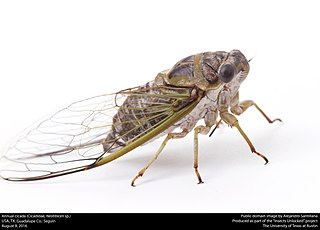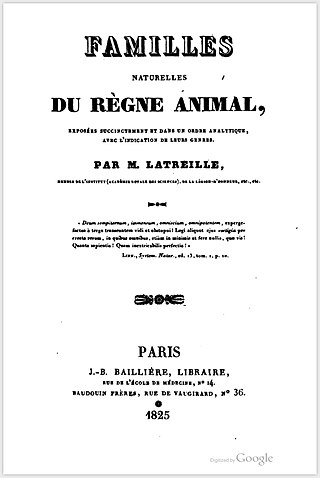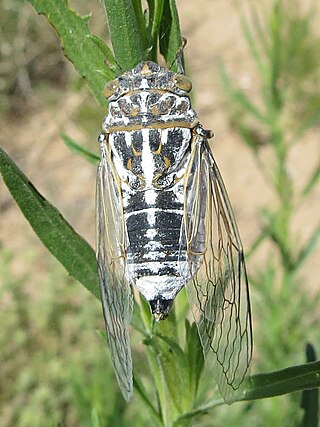
Cicadidae, the true cicadas, is the largest family of cicadas, with more than 3,200 species worldwide. The oldest known definitive fossils are from the Paleocene, a nymph from the Cretaceous Burmese amber has been attributed to the family, but could also belong to the Tettigarctidae.

Cicadas of the genus Neotibicen are large-bodied insects of the family Cicadidae that appear in summer or early fall in eastern North America and formerly Bermuda. Common names include cicada, harvestfly, jar fly, and the misnomer locust.

Pomponia is a genus of cicadas from Asia. A group of species previously placed in Pomponia, containing the largest cicada species found on earth, have recently been moved to Megapomponia. However, the remaining species still form a very heterogeneous group and Duffels and Hayashi (2006) mentioned that several species should probably be transferred to genera like Terpnosia and Leptosemia.

The Cicadinae are a subfamily of cicadas, containing the translucent cicadas. They are robust cicadas and many have gaudy colors, but they generally lack the butterfly-like opaque wing markings found in many species of the related Tibiceninae.
Tibiceninae is a historical subfamily name from the insect family Cicadidae. It was first used by Distant (1889). As of 2021, the name became unavailable to zoological nomenclature due to the suppression of its type genus Tibicen Berthold, 1827 by the International Commission on Zoological Nomenclature. Cicada genera grouped at the subfamily level with genus Lyristes are generally referenced under the name Cicadinae Latreille, 1802.

Cryptotympanini is a tribe of cicadas in the family Cicadidae. They are found in the Nearctic, Palearctic, Indomalaya, Oceania, and Afrotropics.
Tibicenini is a historical tribe name from the insect family Cicadidae, based on the family group taxon established by Distant (1889). As of 2021, the name became unavailable to zoological nomenclature due to the suppression of its type genus Tibicen Berthold, 1827 by the International Commission on Zoological Nomenclature. Cicada genera grouped at the tribe level with genus Lyristes are generally referenced under the name Cryptotympanini Handlirsch, 1925.

Cicadetta is a genus of generally small-bodied annual cicadas widespread across portions of the Palearctic, Indomalayan, and Afrotropical realms. In older scientific and taxonomic literature, this genus was popularly referred to as Melampsalta. These cicadas occur in a diverse spectrum of habitats, although most taxa are typically associated with weedy meadows and tallgrass prairie ecosystems. Several related species from North America were recently transferred to the genus Cicadettana.

Megapomponia is a genus of cicadas from Southeast Asia containing the world's largest cicadas species. It now belongs to the subtribe Megapomponiina and was erected by Michel Boulard to accommodate the world's largest cicada species, Megapomponia imperatoria, the type species of Megapomponia. Boulard included seven species in Megapomponia. Lee and Sanborn, however, re-transferred two species to Pomponia, Pomponia decem and Pomponia rajah.

The Dundubiini are a tribe of cicadas in the family Cicadidae, found in the Palearctic, Indomalaya, Australasia, and the Western Pacific. There are at least 180 described species in Dundubiini.

Tibicen is a historical genus name in the insect family Cicadidae that was originally published by P. A. Latreille in 1825 and formally made available in a translation by A. A. Berthold in 1827. The name was placed on the Official Index of Rejected and Invalid Generic Names in Zoology by the International Commission on Zoological Nomenclature in 2021. Certain European cicada species that were included by some authors in this genus at the time of its suppression are now listed under genus Lyristes Horváth, 1926. Other formerly-Tibicen species are placed in the tribe Cryptotympanini and include the genera Auritibicen Lee, 2015, Hadoa Moulds, 2015 Megatibicen Sanborn and Heath, 2016, and Neotibicen Hill and Moulds, 2015.

The genus Hadoa comprises large-bodied Cicadidae occurring in Western North America. Until recently, these species were in the genus Tibicen, which has now been redefined so as to include only a few European species, while most species from the Eastern and Central US are now placed in Neotibicen and Megatibicen.

Megatibicen is a genus of cicadas in the family Cicadidae, with about 10 described species. Until 2016, these species were included in the genus Tibicen and then briefly in Neotibicen. The species formerly of genera Ameritibicen Lee, 2016 and Gigatibicen Lee, 2016 are now considered species of Megatibicen Sanborn & Heath, 2016.
Abroma is a genus of cicadas in the family Cicadidae. There are at least 20 described species in Abroma.
Panka is a genus of cicadas in the family Cicadidae. About nine described species are in Panka.
Plautilla is a genus of cicadas in the family Cicadidae, found in the Neotropics. There are at least three described species in Plautilla.
Pagiphora is a genus of cicadas in the family Cicadidae, found in the western Palearctic. There are about five described species in Pagiphora.

Dundubia is a genus of cicadas in the subfamily Cicadinae and the type genus of the tribe Dundubiini.

Lyristes is a genus of cicadas from Europe and the Middle East. It was described by G. Horvath in 1926.
Guyalna is a genus of cicadas in the family Cicadidae. It was first described by Boulard and Martinelli in 1996. Members of this genus are characterized by three-segmented tarsi, a rounded timbal cover apex, a pronotum shorter than the mesonotum, the head as wide or slightly wider than the mesonotum, and slightly protruding eyes, according to the authors who first described it.













